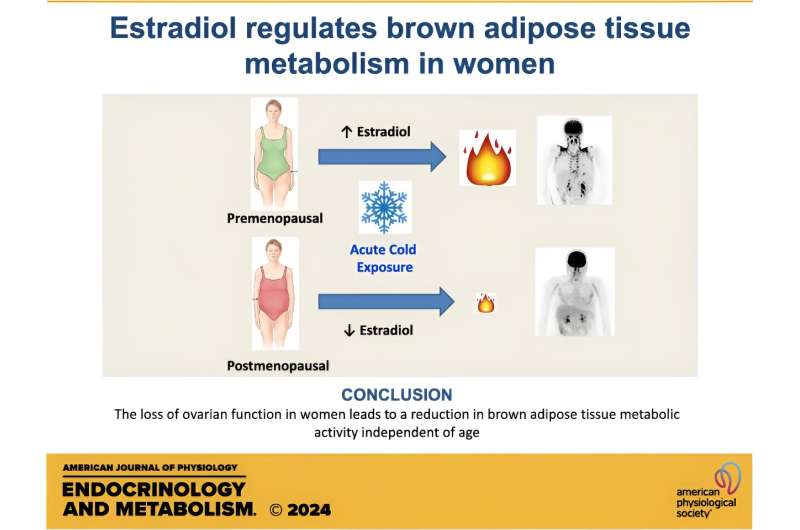This article has been reviewed according to Science X's editorial process and policies. Editors have highlighted the following attributes while ensuring the content's credibility:
fact-checked
trusted source
proofread
'Good' fat metabolism changes tied to estrogen loss, not necessarily to aging, shows study

Brown fat metabolism decreases in older men and women, but the decrease in women is not necessarily tied to age, according to new research. The first-of-its-kind study is published ahead of print in the American Journal of Physiology-Endocrinology and Metabolism.
The body uses brown fat (called brown adipose tissue, or BAT) to stay warm in cold temperatures. Considered a "good" fat, BAT stores energy, burns calories and produces heat (called thermogenesis) when activated. Brown fat may also help regulate glucose and fat metabolism. Most people have a very small amount of brown fat compared to white fat. White fat surrounds the organs and can lead to obesity.
Previous research in rodents has found that BAT metabolic activity decreases when estrogen levels are low, such as after menopause. In a new study—the "first investigation of ovarian status on BAT metabolism in women"—researchers studied pre- and postmenopausal women to determine the role of estrogen in BAT metabolic activity.
The research team studied premenopausal women with normal menstrual cycles and postmenopausal women not on estrogen-based hormonal replacement therapy. Both groups participated in two trials on separate days: one in which they rested at room temperature and one in which the volunteers wore a cold-water perfusion suit. The researchers used positron emission (PET) and computer (CT) tomography to view and measure the rate of BAT oxidative metabolism.
At room temperature, there were no differences in BAT oxidative metabolism between the two groups. In the cold, brown fat oxidative metabolism rates more than doubled in premenopausal women, but only increased 1.4 times in the postmenopausal group. BAT glucose uptake—a measure of how the cells use glucose—was nearly three times higher in premenopausal women.
"These data suggest that the relative contribution of BAT oxidative metabolism to total oxygen consumption during cold exposure is higher in premenopausal women compared to postmenopausal women," the researchers wrote.
The researchers also studied a subset of premenopausal women "to disentangle the effects of biological aging from ovarian aging on BAT metabolism." In this trial, the women's ovarian hormones—namely, estrogen—were suppressed for six months before the room temperature and cold exposure conditions were repeated.
The results were similar to what the research team saw in the postmenopausal women in the original trial. In the premenopausal women who underwent ovarian suppression, BAT oxidative metabolism decreased to a level that was similar to that observed in postmenopausal women.
The researchers also examined BAT tissue density and found that tissue density was lower in postmenopausal women, suggesting a shift toward lipid storage rather than utilization as a fuel. "Collectively, these data suggest that loss of ovarian function leads to a loss of BAT metabolic activity independent of age."
More information: Denis P. Blondin et al, Brown adipose tissue metabolism in women is dependent on ovarian status, American Journal of Physiology-Endocrinology and Metabolism (2024). DOI: 10.1152/ajpendo.00077.2024





















